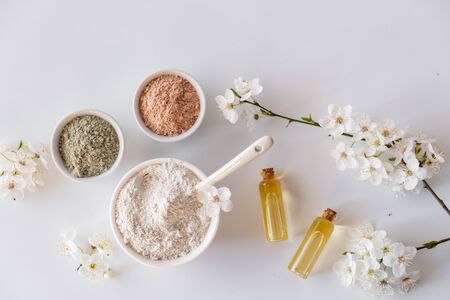Introduction to Ayurvedic Skincare
Ayurveda, the ancient Indian science of life and wellness, holds a special place in our daily routines, especially when it comes to skincare. Rooted in the belief that true beauty emerges from inner harmony and natural balance, Ayurveda emphasizes using herbal ingredients and time-tested rituals passed down through generations. For centuries, Indian households have relied on simple, homemade remedies crafted from nature’s bounty—like rose water, neem leaves, tulsi, and sandalwood—to nourish and rejuvenate the skin. Incorporating these practices into daily life is not just about looking good; it’s about respecting one’s dosha (unique body constitution), maintaining a holistic lifestyle, and drawing on traditional wisdom for sustainable self-care. In this article, we’ll explore how to create your own Ayurvedic face mist and toner at home, blending modern DIY trends with timeless Indian traditions for glowing, balanced skin.
Benefits of Using Homemade Face Mists & Toners
When it comes to skincare, especially in India’s diverse climate, opting for homemade Ayurvedic face mists and toners offers several unique benefits compared to store-bought products. Natural, DIY solutions are not only gentle on the skin but also free from harsh chemicals, artificial fragrances, and preservatives that can irritate or damage sensitive Indian skin types.
Natural vs Store-Bought: Why Choose Homemade?
| Aspect | Homemade (Ayurvedic) | Store-Bought |
|---|---|---|
| Ingredients | Natural, locally sourced herbs and flowers like rose, tulsi, neem, aloe vera | Synthetic chemicals, preservatives, artificial colors and fragrances |
| Suitability for Indian Skin | Customizable for oily, dry, or combination skin prevalent among Indians | One-size-fits-all formula; may not address specific needs |
| Adaptability to Climate | Easily adjusted for hot summers or humid monsoons by changing ingredients | Fixed formulation; might not suit all weather conditions |
| Sensitivity & Allergies | Milder, fewer allergens; easy to avoid known triggers | May contain common allergens; less transparency on ingredients |
| Cultural Relevance | Incorporates traditional remedies trusted over generations in Indian households | Lacks connection with Indian home remedies or Ayurveda principles |
| Cost Effectiveness | Budget-friendly; uses kitchen staples and garden herbs | Relatively expensive due to branding and packaging |
Gentle Care Tailored for You
The Indian climate ranges from humid coastal regions to arid northern plains. Homemade face mists and toners made with ingredients like rose water for cooling or neem for antibacterial benefits can be adapted to your local environment. This means you get a solution that soothes your skin after exposure to sun and pollution without clogging pores or causing irritation.
The Ayurvedic Edge: Balance & Holistic Wellness
Ayurveda emphasizes balance—homemade mists allow you to blend ingredients such as sandalwood for calming Pitta dosha (heat), or vetiver for dryness caused by Vata dosha. These time-tested remedies nurture your skin gently while supporting its natural healing process, making them ideal for daily use across different age groups in Indian families.

3. Essential Ayurvedic Ingredients
When it comes to creating your own homemade Ayurvedic face mist and toner, Indian kitchens are treasure troves of natural ingredients with powerful skin benefits. Here are some of the most popular and effective Ayurvedic ingredients you can use:
Rose Water (Gulab Jal)
Rose water is a staple in Indian households and is known for its cooling and soothing properties. It helps balance the skin’s pH, hydrates deeply, and calms irritation or redness. It also adds a natural glow, making it ideal as a base for any face mist or toner.
Tulsi (Holy Basil)
Tulsi leaves are highly revered in Ayurveda for their antibacterial and purifying qualities. Using tulsi in your skincare helps fight acne, detoxifies the skin, and provides relief from inflammation. The earthy aroma of tulsi is also uplifting for the senses.
Neem
Neem is well-known across India for its potent antibacterial and antifungal effects. It works wonders for oily and acne-prone skin by controlling excess oil, minimizing pores, and preventing breakouts. Neem also helps in fading scars and pigmentation.
Turmeric (Haldi)
Turmeric is a classic Ayurvedic ingredient that brightens the complexion while fighting bacteria and inflammation. Its antioxidant properties help reduce blemishes, even out skin tone, and add a healthy radiance to your face mist or toner.
Sandalwood (Chandan)
Sandalwood powder or oil is valued for its calming fragrance and cooling effect on the skin. It soothes sunburns, reduces redness, and helps lighten marks or dark spots over time. Sandalwood also prevents pimples due to its anti-inflammatory nature.
Aloe Vera
Aloe vera gel is a household remedy across India for healing wounds and soothing irritated skin. Rich in vitamins and minerals, aloe vera hydrates without making the skin greasy, calms rashes or sunburns, and supports overall skin regeneration.
By using these traditional ingredients from your kitchen, you ensure that your homemade Ayurvedic face mist and toner are pure, effective, and rooted in Indian wisdom for naturally glowing skin.
4. DIY Face Mist & Toner Recipes
Ayurveda offers a treasure trove of natural ingredients that are easily found in most Indian kitchens or local markets. Creating your own face mist and toner at home is not only economical, but also ensures you know exactly what goes onto your skin. Below, you’ll find step-by-step recipes for different skin types, making use of time-tested Ayurvedic elements like rose water, neem, tulsi (holy basil), aloe vera, and more.
For Oily Skin
Neem & Tulsi Face Mist
- Take a handful of fresh neem leaves and tulsi leaves. Wash them thoroughly.
- Boil 1 cup of water and add the leaves. Let it simmer for 10 minutes.
- Allow it to cool, then strain the liquid into a spray bottle.
- Add a few drops of lemon juice for added astringency.
- Store in the refrigerator and use within one week.
For Dry Skin
Rose & Aloe Vera Hydrating Toner
- Mix 2 tablespoons of pure rose water with 1 tablespoon of freshly extracted aloe vera gel.
- Stir until well combined. Add 2-3 drops of almond oil if extra hydration is needed.
- Pour the mixture into a clean spray bottle or container.
- Shake well before each use. Store in the fridge for freshness.
For Combination Skin
Cucumber & Mint Refreshing Face Mist
- Blend half a cucumber with a handful of mint leaves and filter the juice using a muslin cloth.
- Add 1 tablespoon rose water to this juice.
- Pour the liquid into a spray bottle and refrigerate.
Quick Reference Table for Ingredients and Benefits
| Skin Type | Main Ingredients | Main Benefits |
|---|---|---|
| Oily | Neem, Tulsi, Lemon Juice | Purifies pores, reduces excess oil, prevents acne |
| Dry | Rose Water, Aloe Vera, Almond Oil | Hydrates deeply, soothes irritation, softens skin |
| Combination | Cucumber, Mint, Rose Water | Cools skin, balances oil levels, refreshes complexion |
Select the recipe that best suits your skin’s needs and enjoy these gentle yet effective homemade Ayurvedic face mists and toners. Regular use can help maintain skin health naturally, aligning with traditional Indian beauty practices.
5. How to Use & Store Your Ayurvedic Face Mist/Toner
Practical Application Tips for Indian Skincare Routines
Incorporating your homemade Ayurvedic face mist or toner into your daily routine is both simple and refreshing. For optimal results, cleanse your face gently with a mild herbal face wash suited to your skin type. Pat your skin dry, then hold the mist bottle about 6-8 inches away from your face. Close your eyes and spritz 2-3 pumps evenly across your face and neck. Allow it to air-dry naturally or pat in gently using clean fingertips. This step preps the skin for better absorption of serums and moisturizers, especially in India’s humid or dry climates. For midday freshness, carry a small bottle in your handbag and spritz whenever you feel dullness, sweat, or exposure to pollution.
Safe Storage Tips for Indian Weather
Since homemade Ayurvedic toners lack chemical preservatives, proper storage is crucial, especially in India’s hot and humid conditions. Always use sterilised glass spray bottles or containers to prevent bacterial growth. Store your face mist in the refrigerator if possible; this not only extends shelf-life but also provides a cooling sensation perfect for tropical heat. If refrigeration isn’t feasible, keep the toner in a cool, shaded place away from direct sunlight and heat sources. Never leave the bottle in your car or near windows.
Shelf-Life & Spoilage Signs
Typically, homemade Ayurvedic toners last about 5-7 days at room temperature or up to 2 weeks when refrigerated. To be safe, make small batches and prepare fresh each week. If you notice any change in smell, colour, or texture, discard immediately—natural ingredients can spoil quickly without preservatives.
Quick Reminders for Indian Lifestyles
– Always use clean hands or cotton pads while handling your toner.
– Avoid sharing bottles to reduce contamination.
– Label each batch with preparation date.
– Adjust frequency of use based on weather; more often during summer, less in monsoon if skin feels oily.
– For travel within India’s varied climates, transfer a portion into a small spray bottle and keep it cool whenever possible.
By following these usage and storage tips tailored for Indian routines and weather conditions, you can enjoy the full benefits of natural Ayurvedic skincare safely every day.
6. Precautions and Customization Tips
Patch Testing: Ensuring Skin Compatibility
Before using any homemade Ayurvedic face mist or toner, it is always wise to perform a patch test. Apply a small amount of your prepared mixture on the inside of your wrist or behind your ear. Wait for 24 hours and observe for any irritation, redness, itching, or swelling. If you notice any adverse reaction, it is best to avoid using that formulation on your face. Remember, natural ingredients can still cause allergies in some individuals.
Allergy Awareness: Know Your Ingredients
Always check the source and purity of every ingredient you use. Many Indian households have traditional herbs and flowers like rose petals, neem leaves, and tulsi readily available. However, if you are allergic to pollen, essential oils, or specific herbs (such as sandalwood or turmeric), omit these from your recipes. When in doubt, consult with a dermatologist or an Ayurvedic practitioner before trying new ingredients.
Adapting Recipes According to Doshas
Vata Dosha (Dry & Sensitive Skin)
If your skin tends to be dry or sensitive (Vata), opt for hydrating and nourishing ingredients such as rose water, aloe vera gel, and honey. Avoid strong astringents like lemon juice which can increase dryness.
Pitta Dosha (Sensitive & Acne-Prone Skin)
Pitta skin types benefit from soothing and cooling botanicals. Use ingredients like cucumber juice, mint leaves, and sandalwood water in your mist or toner. Stay away from spicy or heating components such as cinnamon or clove.
Kapha Dosha (Oily & Congested Skin)
If you have oily or congested skin (Kapha), choose clarifying and balancing elements such as neem water, tulsi infusion, or diluted apple cider vinegar. Avoid overly rich oils which may further clog pores.
Respecting Local Preferences
The beauty of DIY Ayurvedic skincare lies in its flexibility. You can adapt recipes based on locally available herbs and personal preferences. For instance, in South India, jasmine and curry leaves are popular additions for their fragrance and skin benefits. In North India, saffron and rose remain favourites. Always adjust quantities according to what suits your unique skin needs.
Final Thought
Your journey into Ayurvedic DIY skincare is deeply personal—listen to your skin’s response, honour traditional wisdom, and customise each recipe for the most effective and enjoyable results.
7. Conclusion: Embracing the Indian Way to Natural Beauty
Incorporating homemade Ayurvedic face mists and toners into your daily skincare routine is more than just a beauty ritual—it is a celebration of India’s ancient wisdom and holistic approach to self-care. These time-honoured remedies not only nourish your skin with natural, chemical-free ingredients but also connect you to centuries-old traditions rooted deeply in our culture. By consistently using these Ayurvedic practices, you align yourself with both Indian heritage and the principles of modern wellness, promoting harmony between body, mind, and spirit. Remember, glowing and healthy skin is not achieved overnight; it is the result of regular care, patience, and respect for nature’s gifts. So, embrace these simple yet powerful Indian remedies in your everyday routine and rediscover the joy of natural beauty—the Indian way.


